The Election of the President Throughout U.S. History
Part 6: 1928 to 1952 The Election of 1928 Hoover was perhaps most well-known for his role at the head of the U.S. Food Administration. He was also famous for organizing the return of tens of thousands of Americans from Europe after World War I and for his volunteer work helping the countries of Western Europe recover from the war. The Democratic Party nominated New York Gov. Alfred E. Smith, who proved very popular among Democratic voters. Hoover's fame and his pledge to continue to pro-business policies of Harding and Coolidge that had catapulted the country into so much prosperity resulted in a landslide victory again for the Republicans, with Hoover outclassing Smith 444-87 (and even claiming Smith's home state of New York.) The Election of 1932 The stock market crashed in 1929, banks failed, job markets dried up across the country, and many other countries around the world struggled economically as well. Nonetheless, the Republicans renominated Hoover as their standard-bearer in 1932. Hoover argued that he had the answers to the nation's problems.
Understandably, the dismal economy was the dominant issue of the election campaign. Roosevelt promised America a "New Deal," and voters went for it in droves. Roosevelt won 7 million more popular votes than Hoover. The electoral vote was even more of a landslide, 472-59. The Election of 1936 Roosevelt ran for re-election against Republican Alf Landon, the governor of Kansas, who did very little campaigning, which was the norm, and agreed with much of Roosevelt's program, which was not, at least among Republican circles. The result was the most lopsided electoral count in the history of the country. Roosevelt carried all but two states, New Hampshire and Vermont. Landon won eight electoral votes in all and lost his home state in the bargain. Roosevelt outdistanced Landon in the popular vote total by 11 million. The Election of 1940 Breaking with the tradition set by George Washington, Roosevelt opted to run again for re-election in 1940. He campaigned on the strength of his economic policies, which had addressed much of the difficulties faced by the country, and on a promise to keep America out of the war. His opponent in the election was Republican businessman Wendell Wilkie, who emphasized that Roosevelt's policies hadn't dragged the country out of the Great Depression and that war loomed on the horizon. Willkie fared better than Landon and Hoover but couldn't muster enough support to unseat the very popular President. The popular vote was much closer this time, with Roosevelt winning by just fewer than 5 million votes. The electoral difference wasn't even close, 449-82. The Election of 1944 His Republican opponent was New York Gov. Thomas E. Dewey. The GOP strategy was to campaign against the New Deal and its expansive government.
It was the closest any Republican candidate would get against the very popular FDR. Dewey lost by three-and-one-half million votes. The electoral tally was an overwhelming 432-99. It was the last election in which the Democratic nominee carried all of the Southern states.
The Election of 1948 By the time of the election campaign, Truman was deeply unpopular, having clashed with leaders of Congress and failed to live up to many people's expectations, following in the footsteps of the hugely popular FDR. Dewey's campaign was lackluster; Truman's was not. The President criss-crossed the country on a "whistle stop tour," speaking to large crowds in town after town. Opinion polls leading up to election night consistently predicted a Dewey win. Dewey had gained endorsements from more than 500 newspapers.
All signals pointed to a Truman defeat, which is what the Chicago Daily Tribune reported in its afternoon edition on election day. Dewey did not defeat Truman, however. When votes had been counted, the President had won re-election, rather handily, it turned out. The electoral count was 303 for Truman, 189 for Dewey, and 39 for Thurmond. (Wallace carried no states.) The Election of 1952 The country was in the middle of the Korean War, and Cold War fears ran deep throughout the land. The Democratic Party nominated Senator Adlai Stevenson.
The campaign was very much about the fighting against Communism, in Korea and elsewhere. Eisenhower's popularity, in part due to some economic successes at home, proved overwhelming, and his victory was that as well, with the GOP nominee outdistancing Stevenson by nearly seven million popular votes and by an electoral count of 442–89. |
|
Social Studies for Kids
copyright 2002–2025
David White

 In 1928, Coolidge chose not to run for re-election. He certainly could have because he had not been elected to his first term. Succeeding him on the Republican ticket was Secretary of Commerce
In 1928, Coolidge chose not to run for re-election. He certainly could have because he had not been elected to his first term. Succeeding him on the Republican ticket was Secretary of Commerce  The Great Depression began on Hoover's watch and just got worse.
The Great Depression began on Hoover's watch and just got worse. 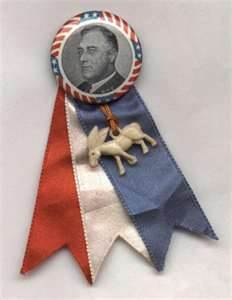 His Democratic challenger was New York Gov.
His Democratic challenger was New York Gov. The Great Depression continued throughout Roosevelt's first term. Some of the proposals the President introduced had an effect, putting many people back to work. The newly implemented Social Security program proved to be a huge hit. Other plans met with some success; still others, notably the National Recovery Act, ran into trouble (in the case of the NRA, being declared unconstitutional by the Supreme Court).
The Great Depression continued throughout Roosevelt's first term. Some of the proposals the President introduced had an effect, putting many people back to work. The newly implemented Social Security program proved to be a huge hit. Other plans met with some success; still others, notably the National Recovery Act, ran into trouble (in the case of the NRA, being declared unconstitutional by the Supreme Court).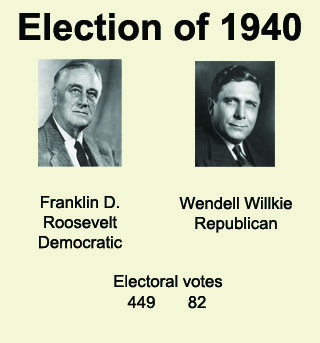 As the 1930s wound to a close, World War II had begun and the Great Depression was dissipating. Through various means of helping opponents of Nazi Germany, many U.S. businesses had found their economic footing again.
As the 1930s wound to a close, World War II had begun and the Great Depression was dissipating. Through various means of helping opponents of Nazi Germany, many U.S. businesses had found their economic footing again. 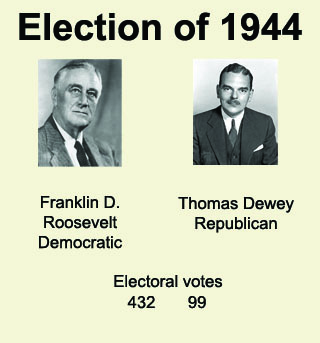 With World War II still raging, Roosevelt ran again in 1944, campaigning on the strength of America's turning back the tide of the war in both Europe and the Pacific. (After the
With World War II still raging, Roosevelt ran again in 1944, campaigning on the strength of America's turning back the tide of the war in both Europe and the Pacific. (After the 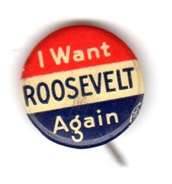 bombing of Pearl Harbor in 1941, the U.S. had entered the war and fought against Germany, Italy, and Japan. After a series of initial setbacks, the U.S. Armed Forces had put together a string of victories. By November of 1944, the outlook was far different, with the success of the D-Day invasion fresh in voters' minds. Roosevelt also pointed out that the country had come out of the Depression.
bombing of Pearl Harbor in 1941, the U.S. had entered the war and fought against Germany, Italy, and Japan. After a series of initial setbacks, the U.S. Armed Forces had put together a string of victories. By November of 1944, the outlook was far different, with the success of the D-Day invasion fresh in voters' minds. Roosevelt also pointed out that the country had come out of the Depression.
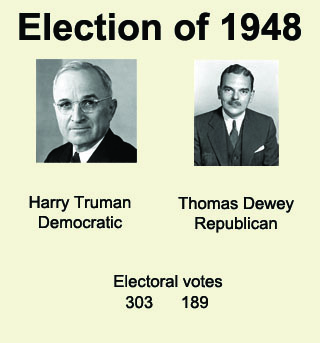 The election of 1948 is one of the most famous in history for its outcome and how it was announced. Representing the Democratic Party was the incumbent President,
The election of 1948 is one of the most famous in history for its outcome and how it was announced. Representing the Democratic Party was the incumbent President, 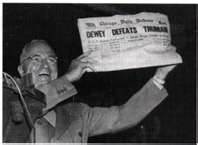
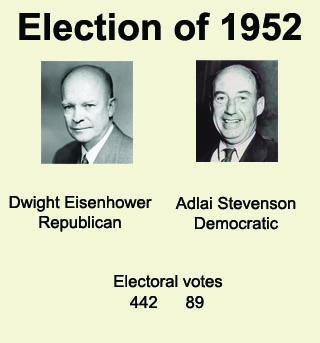 Truman decided not to run for re-election in 1952 (although he could have legally run again, having become President when Roosevelt died and then served only one full term).
Truman decided not to run for re-election in 1952 (although he could have legally run again, having become President when Roosevelt died and then served only one full term). 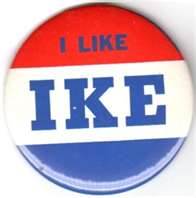 His Republican challenger was war hero
His Republican challenger was war hero 
